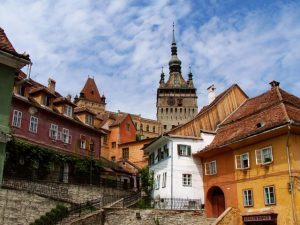Day Tour to The Clay Castle (the Valley of Fairies)
Day Tour to The Clay Castle (Faires Valley)
Day Tour to The Clay Castle (the Valley of Fairies),Lipitani Horses & Cistercian Abbey Carta
The Clay Castle
The wonder of clay! The Fairies’ valley is a clay castle, built with the money that came from private funds in 2014, with an architecture inspired by the fairy tale castles, from the Romanian folk tales. The wonder, the marvel from the valley of the fairies! This is the impression this magical place instills in all its visitors. The clay castle is situated in a mountainous area with idyllic scenery in Sibiu County. The cottage from the movie animation Snow White replicates the sensation conveyed by the experience of this castle’s wonders.


Lipizzaner Horse Stables

After the visit to the Clay Castle, you may want to hear more about animals: The history of the Lipizzaner started in 1580, when Charles II of Austria established the stud farm in Lipiza in today’s Slovenia. The aim was to breed a horse suitable for the imperial court: excellent, resistant, impressive, which would express richness and splendor in its character. At the origin of the species are the horses from the mountains, resistant, having strong personality, and the stallions originating from Naples and Spain. The first import from Spain had great importance, it included 24 mares of Arabian origin and 9 stallions. On the other hand, the eastern influence is of equal importance, namely the Arabian mares from Radauti and Babolna. After the initial selection focusing on the requirements of the founder, they switched to pure breeding. In order to exclude the disadvantages of incest, starting from the 18th century they initiated breeding according to genealogical lines. Thus the classical 8 lines of stallions, 17 classical families of mares were formed, as well as the next families of mares acknowledged until these days: 14 Croatian, 1 Slovenian, 13 Hungarian and 14 Romanian, which show the uniqueness of the species.
Lipizzaner Horse Stables

After the visit to the Clay Castle, you may want to hear more about animals: The history of the Lipizzaner started in 1580, when Charles II of Austria established the stud farm in Lipiza in today’s Slovenia. The aim was to breed a horse suitable for the imperial court: excellent, resistant, impressive, which would express richness and splendor in its character. At the origin of the species are the horses from the mountains, resistant, having strong personality, and the stallions originating from Naples and Spain. The first import from Spain had great importance, it included 24 mares of Arabian origin and 9 stallions. On the other hand, the eastern influence is of equal importance, namely the Arabian mares from Radauti and Babolna. After the initial selection focusing on the requirements of the founder, they switched to pure breeding. In order to exclude the disadvantages of incest, starting from the 18th century they initiated breeding according to genealogical lines. Thus the classical 8 lines of stallions, 17 classical families of mares were formed, as well as the next families of mares acknowledged until these days: 14 Croatian, 1 Slovenian, 13 Hungarian and 14 Romanian, which show the uniqueness of the species.


The Cistercian Abbey Carta

The history of this abbey is enriched by legends and mysteries that stretch over a period of 800 years. The people from Carta recount stories about paranormal phenomena, secret tunnels, hidden treasures and disturbing acts. The locals revealed to be afraid of this monastery. The Cistercian monks that inhabited this place are surrounded by myths and mysteries. The secret galleries elicit curiosity and fear. It is rumored that there are secret tunnels that start from the castle and cross the whole village, until the river Olt. Many people tried to dig and discover these tunnels, and at the same time, the vault of the Cistercian knights. The locals tell about the ghosts that walk freely at night through the monastery because they haven’t found their peace. One of the legends speaks about how 13 monks (alike the 12 apostles from the Bible), barefooted and only dressed with rags, crossed, in 1190, thousands of kilometers, precisely from Burgundia, and stopped in Carta. Because of their strenuous life the monks could survive only 35-40 years. Behind the monastery there is a swamp that is believed to be without a bottom. From the swamp, some people say, there can be heard, every night, the bells of the church singing. It is said that the bells were thrown there by the Tatars in 1241, which, after ransacking the church, killed the abbot. After 1550 those that were still alive converted to Protestantism and the church became Protestant. The massive walls and the magnificent architecture are part of the Carta abbey, a unique and, at the same time, attractive place.
The Cistercian Abbey Carta

The history of this abbey is enriched by legends and mysteries that stretch over a period of 800 years. The people from Carta recount stories about paranormal phenomena, secret tunnels, hidden treasures and disturbing acts. The locals revealed to be afraid of this monastery. The Cistercian monks that inhabited this place are surrounded by myths and mysteries. The secret galleries elicit curiosity and fear. It is rumored that there are secret tunnels that start from the castle and cross the whole village, until the river Olt. Many people tried to dig and discover these tunnels, and at the same time, the vault of the Cistercian knights. The locals tell about the ghosts that walk freely at night through the monastery because they haven’t found their peace. One of the legends speaks about how 13 monks (alike the 12 apostles from the Bible), barefooted and only dressed with rags, crossed, in 1190, thousands of kilometers, precisely from Burgundia, and stopped in Carta. Because of their strenuous life the monks could survive only 35-40 years. Behind the monastery there is a swamp that is believed to be without a bottom. From the swamp, some people say, there can be heard, every night, the bells of the church singing. It is said that the bells were thrown there by the Tatars in 1241, which, after ransacking the church, killed the abbot. After 1550 those that were still alive converted to Protestantism and the church became Protestant. The massive walls and the magnificent architecture are part of the Carta abbey, a unique and, at the same time, attractive place.


TOUR DETAILS
Departure and return: Brasov
You can also create your own itinerary for a customized trip.
Prices:
• 1, 2 persons – 100 euros/group
• 3, 6 persons – 40 euros/person
• +6 persons – 35 euros/person
• +20 persons or more – negotiable
You can join other groups and pay less, so contact us NOW!
Availability: All year round.
Included:
• Transport by modern car/minivan
• English speaking tour guide
Not Included:
• Lunch and Entrance fees at Museums
Related Trips









